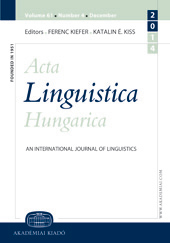Bidirectional and unidirectional comitative constructions in Hungarian: A psycholinguistic investigation at the interface of argument structure and semantics
Bidirectional and unidirectional comitative constructions in Hungarian: A psycholinguistic investigation at the interface of argument structure and semantics
Author(s): István Fekete, Csaba PléhSubject(s): Semantics, Psycholinguistics
Published by: Akadémiai Kiadó
Keywords: comitative-instrumental suffix; argument structure; self-paced reading; sentence processing; anaphora resolution;
Summary/Abstract: This paper explores how bidirectional and unidirectional comitative constructions are processed at the level of argument structure. Bidirectional comitative constructions describe events where the two actors undergo the same effect described by the predicate (e.g., John was kissing with Mary), whereas unidirectional comitative constructions describe events in which one of the actors is the agent, and the other one is the patient (e.g., John was messing with Mary). In particular, we used the self-paced reading paradigm to determine if the two constructions access distinct mental representations. The findings suggest that distinct mental representations are activated automatically by bidirectional and unidirectional verbs during online language comprehension.
Journal: Acta Linguistica Hungarica (Since 2017 Acta Linguistica Academica)
- Issue Year: 58/2011
- Issue No: 1
- Page Range: 3-23
- Page Count: 21
- Language: English

